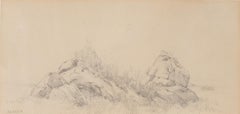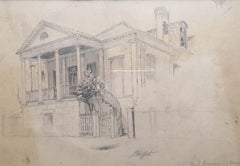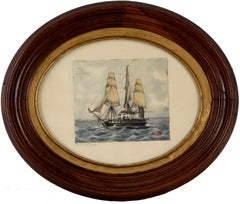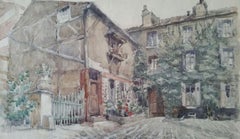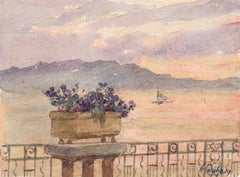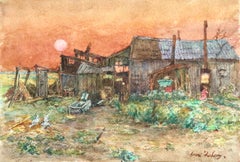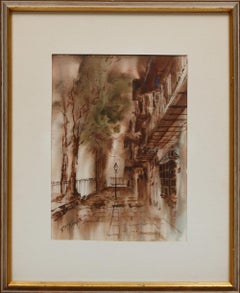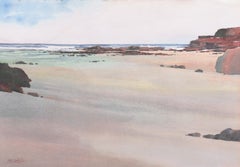Graphite Landscape Drawings and Watercolors
to
1
7
6
5
12
1
11
2
Overall Height
to
Overall Width
to
106
24
17
13
8
4
3
3
2
2
1
1
9
4
4
3
3
3
2
2
2
2
2
1
1
1
1
1
1
1
1
1
2
11
2
1
5
1
5
2
1
1
1
3,469
947
915
551
116
Style: Impressionist
Medium: Graphite
"Study off Newport, Rhode Island" John Singer Sargent Drawing, Impressionism
Located in New York, NY
John Singer Sargent
Study off Newport, Rhode Island, 1876
Signed in pencil "JS265A" lower left
Pencil on paper
5 x 10 inches
Provenance:
Estate of the artist
Grand Central Art Galleries, New York, 1959
Mr. William H. Bender Jr
Sotheby's New York, September 19, 1987
Private Collection 1987-2000
Mark Borghi Fine Art Inc., circa 2002
Private Collection (acquired from the above), New York
Recognized as the leading portraitist in England and the United States at the turn of the century, John Singer Sargent was acclaimed for his elegant and very stylish depictions of high society. Known for his technical precocity, he shunned traditional academic precepts in favor of a modern approach towards technique, color and form, thereby making his own special contribution to the history of grand manner portraiture.
A true cosmopolite, he was also a painter of plein air landscapes and genre scenes, drawing his subjects from such diverse locales as England, France, Italy and Switzerland. In so doing, Sargent also played a vital role in the history of British and American Impressionism.
Sargent was born in Florence in 1856. He was the first child of Dr. Fitzwilliam Sargent, a surgeon from an old New England family, and Mary Newbold Singer, the daughter of a Philadelphia merchant. His parents were among the many prosperous Americans who adopted an expatriate lifestyle during the later nineteenth century. Indeed, Sargent's family traveled constantly throughout the Continent and in England, a mode of living that enriched Sargent both culturally and socially. He ultimately became fluent in French, Italian and German, in addition to English.
Having developed an interest in drawing as a boy, Sargent received his earliest formal instruction in Rome in 1869, where he was taught by the German-American landscape painter Carl Welsch. Following this, he attended the Accademia di Belle Arti in Florence during 1873-74.
In the spring of 1874, Sargent's family moved to Paris, enabling him to continue his training there. He soon entered the studio of Charles-Emile-Auguste Carolus-Duran. In contrast to most French academic painters, Carolus-Duran taught his students to paint directly on the canvas, capturing the essence of his subject through relaxed brushwork, a tonal palette and strong chiaroscuro. Although Sargent also spent four years studying drawing under Léon Bonnat at the Ecole des Beaux-Arts, it was Carolus-Duran's approach that would form the aesthetic basis of his style.
Upon his teacher's advice, Sargent also traveled to Spain and Holland to study the work of old master painters such as Diego Velázquez and Frans Hals, both of whom also employed deft, fluid techniques.
In 1876, Sargent made his first visit to the United States, claiming his American citizenship and visiting the Philadelphia Centennial Exposition. One year later, he spent the summer in Cancale, in France's Brittany region, where he painted outdoors, applying Carolus-Duran's strategies to portrayals of fishing folk on sunlit beaches. His reputation in Paris was established in 1878 when his Oyster Gatherers of Cancale (1878; Corcoran Gallery of Art, Washington, D.C.) won an Honorable Mention at that year's Salon.
During the early 1880s, Sargent began making painting trips abroad, working in Venice in 1880 and 1882, where he painted street scenes and interiors notable for their brilliant play of light and shadow. He also embarked on what would be a lucrative career as a portraitist, producing such well known works as The Daughters of Edward Darley Boit (1882; Museum of Fine Arts, Boston).
His early commissions also included an image of Madame Pierre Gautreau. A renowned beauty and member of Parisian society, Madame Gautreau was known for her bold, unorthodox approach towards fashion. In her portrait, entitled "Madame X" (1884; Metropolitan Museum of Art, New York), Sargent effectively captured her distinctive aura. However, his daring realism, coupled with fact that he portrayed a diamond shoulder strap falling off one of her shoulders, caused such an uproar that his career in France was seriously compromised.
As a result of the controversy surrounding "Madame X,"Sargent left Paris in 1886, settling permanently in London. He subsequently flourished in the English capital, becoming the leading portrait painter to the upper classes. Those who shared Sargent's sense of refinement and sophistication, as well as his international viewpoint, were especially drawn to his fashionable French style.
In addition to patronage from such prominent British families as the Wertheimers and the Marlboroughs, Sargent received an equal number of American commissions, many of them secured by artists and architects he had met during his student days in Paris, among them painters J. Carroll Beckwith and Julian Alden Weir and architect Stanford White. On a painting tour to America during 1887-1888, he portrayed members of notable families from Boston and New York, including Mrs. Jacob Wendell and Elizabeth Allen...
Category
1870s Impressionist Graphite Landscape Drawings and Watercolors
Materials
Paper, Pencil, Graphite
Beauregard House, New Orleans
Located in New Orleans, LA
Louis Oscar Griffith (1875-1956) was an American painter known for his etchings, paintings, and aquatints of landscapes, especially scenes of Brown County, Indiana, New Orleans, LA and Texas. Griffith was born in Indiana in 1875 but later moved to Dallas, TX with his family. As a teen, he took art lessons with acclaimed landscape artist, Frank Reaugh...
Category
1910s Impressionist Graphite Landscape Drawings and Watercolors
Materials
Paper, Graphite
19th Century Maritime Seascape, USS Steam Frigate Niagara
Located in Soquel, CA
19th century maritime seascape of a naval ship similar to those used in the war of 1812, by William B. Hoff (American, 1846-1903). This miniature wat...
Category
19th Century American Impressionist Graphite Landscape Drawings and Watercolors
Materials
Paper, Watercolor, Graphite
Mid 20th Century, Old Luxembourg, La Passerelle and Ramparts
Located in Cirencester, Gloucestershire
Old Luxembourg. La Passerelle and The Ramparts
by Leonard Machin Rowe (1880-1968)
signed and inscribed front lower right corner. Inscribed, dated and s...
Category
1950s Impressionist Graphite Landscape Drawings and Watercolors
Materials
Graphite, Watercolor
Mid 20th Century, Belgium, A Brussels Street Scene
Located in Cirencester, Gloucestershire
Belgium. Brussels - A Street Scene
by Leonard Machin Rowe (1880-1968)
signed front lower right corner, inscribed, dated and signed to the back
watercolour painting on artist's paper,...
Category
1950s Impressionist Graphite Landscape Drawings and Watercolors
Materials
Graphite, Watercolor
Ecole de Paris Mid 20th Century Paris: Atelier Studio French Watercolour
By Henri Miloch
Located in Cirencester, Gloucestershire
Paris: Atelier Rue Alain Chartier
by Henri Miloch (1898-1979)
unsigned but inscribed by Miloch verso
watercolour and graphite painting on artist's paper, unframed
sheet: 11 x 14 inc...
Category
1940s Impressionist Graphite Landscape Drawings and Watercolors
Materials
Watercolor, Graphite
Mid 20th Century, Wales, Caernarfon Castle
Located in Cirencester, Gloucestershire
Wales: Caernarfon Castle
by Leonard Machin Rowe (1880-1968)
signed front lower right, inscribed and signed to the back
watercolour painting on artist's paper, unframed
Image 9.5 ...
Category
1950s Impressionist Graphite Landscape Drawings and Watercolors
Materials
Watercolor, Graphite
Mid 20th Century, Belgium, A Brussels Market Lottery Seller Scene
Located in Cirencester, Gloucestershire
Belgium. Brussels - A Market Lottery Seller
by Leonard Machin Rowe (1880-1968)
signed, dated and inscribed front lower left corner, inscribed and signed to the back
watercolour paint...
Category
1950s Impressionist Graphite Landscape Drawings and Watercolors
Materials
Watercolor, Graphite
Mid 20th Century, Belgium, A Gent Morning Market
Located in Cirencester, Gloucestershire
Belgium. Gent - A Morning Market
by Leonard Machin Rowe (1880-1968)
signed and inscribed front lower right corner, inscribed and signed to the back
watercolour painting on artist's ...
Category
1950s Impressionist Graphite Landscape Drawings and Watercolors
Materials
Watercolor, Graphite
Preliminary Drawing for the color aquatint "Street Gossip"
Located in Fairlawn, OH
Preliminary Drawing for the color aquatint "Street Gossip"
Signed by the artist in pencil lower left
Graphite on tracing paper, 1916-1917
An impre...
Category
1910s American Impressionist Graphite Landscape Drawings and Watercolors
Materials
Graphite
"Horse Cart"
Located in Lambertville, NJ
Jim’s of Lambertville Fine Art Gallery is proud to present this piece by Daniel Garber (1880 - 1958).
One of the two most important and, so far, the most valuable of the New Hope Sc...
Category
Early 20th Century American Impressionist Graphite Landscape Drawings and Watercolors
Materials
Paper, Graphite
"Central Park"
Located in Lambertville, NJ
Jim’s of Lambertville is proud to offer this artwork.
Signed. Complemented by a hand carved and gilt frame.
William L. Lathrop (1859-1938)
Deemed “Father of the New Hope Art Colony”, William Langson Lathrop was born in Warren, Illinois. He was largely self-taught, having only studied briefly with William Merritt Chase in 1887, at the Art Students League. Lathrop first moved east in the early 1880s, and took a job at the Photoengraving Company in New York City. While there, he befriended a fellow employee, Henry B. Snell. The two men became lifelong friends and ultimately, both would be considered central figures among the New Hope Art Colony.
Lathrop's early years as an artist were ones of continuing struggle. His efforts to break through in the New York art scene seemed futile, so he scraped enough money together to travel to Europe with Henry Snell in1888. There he met and married an English girl, Annie Burt. Upon returning to New York, he tried his hand at etching, making tools from old saw blades. Even though his prints were extremely beautiful, he still was impoverished. Lathrop would return to his family in Ohio, before once again attempting the New York art scene. In 1899, with great trepidation, he submitted five small watercolors to an exhibit at the New York Watercolor Club. He won the Evans Prize, the only award given, and four of the five paintings were sold the opening night. At age forty Lathrop’s career would finally take off and he became an “overnight success
Lathrop came to Phillips Mill for the first time in1898, to visit his boyhood friend, Dr. George Marshall. Shortly after, he and his family purchased the old miller’s house from Dr. Marshall. The Lathrop’s home became a social and artistic center for the growing New Hope colony. Tea and fascinating conversation was the “order of the day” every Sunday. This was a scene fondly recalled by many younger art students that Lathrop taught privately at Phillips Mill. It was common to see groups of his students painting and sketching along the banks of the canal or aboard his canal boat. He had previously taught in the Poconos and at the Lyme, Connecticut Summer School in1907, but Phillips Mill always remained Lathrop’s permanent address.
In 1928, a committee headed by Lathrop was formed to purchase the old Phillips Mill building as a place to hold community gatherings and art exhibitions. The committee had success and in 1929 the Phillips Mill Community Association was formed. This became the center of the New Hope Art Colony holding annual exhibitions and still operating today.
In 1930, Lathrop had built a sailboat he named the “Widge”. For eight consecutive seasons he sailed it along the coast of Long Island...
Category
Early 20th Century American Impressionist Graphite Landscape Drawings and Watercolors
Materials
Paper, Graphite
'Baja Beach, Rosarito', Carnegie and Metropolitan Museums, Smithsonian, NYMOMA
Located in Santa Cruz, CA
Signed lower left, 'R.R. Dvorak' for Robert Regis Dvorak (American, 20th century) and painted circa 1995.
A panoramic coastal landscape showing a serene expanse of Rosarito beach in Mexico's Baja California by this much-exhibited and well-listed California artist whose work is held in the permanent collections of national institutions including the Metropolitan Museum of Art and New York's Museum of Modern Art.
Robert Dvorak received his Bachelor of Architecture degree from the University of Illinois, his Master of Architecture degree from the University of California, Berkeley and was then awarded a two year Fellowship at the American Academy in Rome. He served as professor of architecture for seven years at the University of Oregon and for a further two years at the University of California, Berkeley. At UCB, he taught design and communication skills including drawing, film-making, watercolor painting and other graphic media. Dvorak was subsequently awarded a grant from the California Arts Council to promote art and creativity for elementary school teachers and children. Dvorak draws on a rich background of unusual experience having been a member of the moon shot...
Category
1990s Impressionist Graphite Landscape Drawings and Watercolors
Materials
Graphite, Paper, Watercolor
Related Items
La Vue - Juan les Pins - 19th Century Watercolor, Flowers by Sea Landscape Duhem
By Henri Duhem
Located in Marlow, Buckinghamshire
Watercolour on paper circa 1925 by Henri Duhem depicting a view of the sea from the promenade at Juan les Pins on the French Riviera. A flower box of pur...
Category
Early 20th Century Impressionist Graphite Landscape Drawings and Watercolors
Materials
Paper, Watercolor
À la ferme - coucher de soleil - 19th Century Watercolor, Landscape by H Duhem
By Henri Duhem
Located in Marlow, Buckinghamshire
Watercolour on paper circa 1925 depicting a young girl running through a farmyard as the sun sets red in the distance. Signed lower right. This painting is not currently framed but a...
Category
Early 20th Century Impressionist Graphite Landscape Drawings and Watercolors
Materials
Paper, Watercolor
Le Ruisseau - Impressionist Watercolor, Figure by Stream in Landscape by H Duhem
By Henri Duhem
Located in Marlow, Buckinghamshire
A lovely watercolour on paper circa 1905 by French Impressionist painter Henri Duhem depicting a woman in a blue dress taking a stroll along the path beside a stream. The trees and f...
Category
Early 20th Century Impressionist Graphite Landscape Drawings and Watercolors
Materials
Paper, Watercolor
Garland Studies I
Located in New York, NY
Image dimensions: 7 ¼ x 10 ½ inches
Framed dimensions: 16 ½ x 20 inches
To produce his murals, Sargent painted monumental canvases in his studios in London and Boston, adhering them...
Category
1920s American Impressionist Graphite Landscape Drawings and Watercolors
Materials
Paper, Pencil
Cottages in Sherbourne, Traditional English Landscape Watercolour Painting
Located in Deddington, GB
Elizabeth Chalmers. Watercolour painting of cottages and gardens in the Cotswold village of Sherbourne.
Size: H:29.00 cm x W:44.50 cm.
Artist Bio: Elizabeth Chalmers was born in N...
Category
21st Century and Contemporary Impressionist Graphite Landscape Drawings and Watercolors
Materials
Watercolor, Paper
H 11.42 in W 17.52 in D 0.04 in
"Monhegan Island, Maine, " Edward Dufner, American Impressionism Landscape View
Located in New York, NY
Edward Dufner (1872 - 1957)
Monhegan Island, Maine
Watercolor on paper
Sight 16 x 20 inches
Signed lower right
With a long-time career as an art teacher and painter of both 'light' and 'dark', Edward Dufner was one of the first students of the Buffalo Fine Arts Academy to earn an Albright Scholarship to study painting in New York. In Buffalo, he had exchanged odd job work for drawing lessons from architect Charles Sumner. He also earned money as an illustrator of a German-language newspaper, and in 1890 took lessons from George Bridgman at the Buffalo Fine Arts Academy.
In 1893, using his scholarship, Dufner moved to Manhattan and enrolled at the Art Students League where he studied with Henry Siddons Mowbray, figure painter and muralist. He also did illustration work for Life, Harper's and Scribner's magazines.
Five years later, in 1898, Dufner went to Paris where he studied at the Academy Julian with Jean-Paul Laurens and privately with James McNeill Whistler. Verification of this relationship, which has been debated by art scholars, comes from researcher Nancy Turk who located at the Smithsonian Institution two 1927 interviews given by Dufner. Turk wrote that Dufner "talks in detail about Whistler, about how he prepared his canvasas and about numerous pieces he painted. . . A great read, the interview puts to bed" the ongoing confusion about whether or not he studied with Whistler.
During his time in France, Dufner summered in the south at Le Pouleu with artists Richard Emil Miller...
Category
Early 20th Century American Impressionist Graphite Landscape Drawings and Watercolors
Materials
Paper, Watercolor
"Train Station, " Max Kuehne, Industrial City Scene, American Impressionism
By Max Kuehne
Located in New York, NY
Max Kuehne (1880 - 1968)
Train Station, circa 1910
Watercolor on paper
8 1/4 x 10 1/4 inches
Signed lower right
Provenance:
Private Collection, Illinois
Max Kuehne was born in Halle, Germany on November 7, 1880. During his adolescence the family immigrated to America and settled in Flushing, New York. As a young man, Max was active in rowing events, bicycle racing, swimming and sailing. After experimenting with various occupations, Kuehne decided to study art, which led him to William Merritt Chase's famous school in New York; he was trained by Chase himself, then by Kenneth Hayes Miller. Chase was at the peak of his career, and his portraits were especially in demand. Kuehne would have profited from Chase's invaluable lessons in technique, as well as his inspirational personality. Miller, only four years older than Kuehne, was another of the many artists to benefit from Chase's teachings. Even though Miller still would have been under the spell of Chase upon Kuehne's arrival, he was already experimenting with an aestheticism that went beyond Chase's realism and virtuosity of the brush. Later Miller developed a style dependent upon volumetric figures that recall Italian Renaissance prototypes.
Kuehne moved from Miller to Robert Henri in 1909. Rockwell Kent, who also studied under Chase, Miller, and Henri, expressed what he felt were their respective contributions: "As Chase had taught us to use our eyes, and Henri to enlist our hearts, Miller called on us to use our heads." (Rockwell Kent, It's Me O Lord: The Autobiography of Rockwell Kent. New York: Dodd, Mead and Co., 1955, p. 83). Henri prompted Kuehne to search out the unvarnished realities of urban living; a notable portion of Henri's stylistic formula was incorporated into his work.
Having received such a thorough foundation in art, Kuehne spent a year in Europe's major art museums to study techniques of the old masters. His son Richard named Ernest Lawson as one of Max Kuehne's European traveling companions. In 1911 Kuehne moved to New York where he maintained a studio and painted everyday scenes around him, using the rather Manet-like, dark palette of Henri.
A trip to Gloucester during the following summer engendered a brighter palette. In the words of Gallatin (1924, p. 60), during that summer Kuehne "executed some of his most successful pictures, paintings full of sunlight . . . revealing the fact that he was becoming a colorist of considerable distinction." Kuehne was away in England the year of the Armory Show (1913), where he worked on powerful, painterly seascapes on the rocky shores of Cornwall. Possibly inspired by Henri - who had discovered Madrid in 1900 then took classes there in 1906, 1908 and 1912 - Kuehne visited Spain in 1914; in all, he would spend three years there, maintaining a studio in Granada. He developed his own impressionism and a greater simplicity while in Spain, under the influence of the brilliant Mediterranean light. George Bellows convinced Kuehne to spend the summer of 1919 in Rockport, Maine (near Camden). The influence of Bellows was more than casual; he would have intensified Kuehne's commitment to paint life "in the raw" around him.
After another brief trip to Spain in 1920, Kuehne went to the other Rockport (Cape Ann, Massachusetts) where he was accepted as a member of the vigorous art colony, spearheaded by Aldro T. Hibbard. Rockport's picturesque ambiance fulfilled the needs of an artist-sailor: as a writer in the Gloucester Daily Times explained, "Max Kuehne came to Rockport to paint, but he stayed to sail." The 1920s was a boom decade for Cape Ann, as it was for the rest of the nation. Kuehne's studio in Rockport was formerly occupied by Jonas Lie.
Kuehne spent the summer of 1923 in Paris, where in July, André Breton started a brawl as the curtain went up on a play by his rival Tristan Tzara; the event signified the demise of the Dada movement. Kuehne could not relate to this avant-garde art but was apparently influenced by more traditional painters — the Fauves, Nabis, and painters such as Bonnard. Gallatin perceived a looser handling and more brilliant color in the pictures Kuehne brought back to the States in the fall. In 1926, Kuehne won the First Honorable Mention at the Carnegie Institute, and he re-exhibited there, for example, in 1937 (Before the Wind). Besides painting, Kuehne did sculpture, decorative screens, and furniture work with carved and gilded molding. In addition, he designed and carved his own frames, and John Taylor Adams encouraged Kuehne to execute etchings. Through his talents in all these media he was able to survive the Depression, and during the 1940s and 1950s these activities almost eclipsed his easel painting. In later years, Kuehne's landscapes and still-lifes show the influence of Cézanne and Bonnard, and his style changed radically.
Max Kuehne died in 1968. He exhibited his work at the National Academy of Design, the Art Institute of Chicago, the Carnegie Institute in Pittsburgh, the Memorial Art Gallery of the University of Rochester, and in various New York City galleries. Kuehne's works are in the following public collections: the Detroit Institute of Arts (Marine Headland), the Whitney Museum (Diamond Hill...
Category
1910s American Impressionist Graphite Landscape Drawings and Watercolors
Materials
Paper, Watercolor
A Canal in Venice, Hanging Out The Washing......
Located in Cotignac, FR
A watercolour on paper view of a canal in Venice by French artist Paule Soulé. The pain ting is signed bottom right and presented in a gilt and painted wood frame under glass.
A cha...
Category
Early 20th Century Impressionist Graphite Landscape Drawings and Watercolors
Materials
Watercolor, Pencil, Paper
The Jurassic Coast, Dorset.
By Ruskin Spear
Located in Cotignac, FR
An English watercolour on paper coastal scene signed with initials 'RS' bottom right. Presented in its original gilt wood frame under glass with trade label to the backboard from Deighton’s Strand Gallery. This gallery was well-known during the 1930s as fine art dealers and frame makers – it was located off Trafalgar square.
Though he often signed with his full name Ruskin Spear's work on paper 'Hammersmith Grove' is signed in the same initials as our work and hence the attribution. This work is also stylistically similar to his other drawings of seascapes and coastal landscapes.
This is a charming and fresh view of a coastal landscape probably the Jurassic coast of Dorset or his beloved Cornwall. The vertiginous composition gives it an angular almost abstract form highlighted by the contrast between the colour of the rockface, the vegetation and the blue sea. The work is in nice condition and wonderful to have the original framing.
Initially influenced by Walter Sickert, the Camden Town Group...
Category
Early 20th Century Impressionist Graphite Landscape Drawings and Watercolors
Materials
Watercolor, Paper
'Moss Beach, Monterey, California', Pacific Coastal Landscape, ASL NYC, Benezit
By Elmer Wachtel
Located in Santa Cruz, CA
An early-20th-century, landscape showing a view of the coastline at Moss Beach in Monterey County with slate-blue skies overhead and a view towards a stand ...
Category
Early 1900s American Impressionist Graphite Landscape Drawings and Watercolors
Materials
Gouache, Watercolor, Paper
Village in the Ural Mountains - Mid Century Landscape
Located in Soquel, CA
Detailed and vibrant mid century mountain village landscape by an unknown artist. Signed ("Dosa" or "Josa") and dated ("47") in the lower ri...
Category
1940s Impressionist Graphite Landscape Drawings and Watercolors
Materials
Paper, Gouache, Watercolor
Morning Near Arizona, 1880s Summer Southwestern Desert Landscape Drawing
Located in Denver, CO
Morning Near Arizona, (Desert Landscape) is an original color pencil drawing from 1888 by George Elbert Burr (1859-1939). Portrays a spring/summer landscape with a tree and fauna, cl...
Category
1880s American Impressionist Graphite Landscape Drawings and Watercolors
Materials
Archival Paper, Color Pencil
H 17 in W 20.25 in D 1 in
Previously Available Items
Pirate's Alley, New Orleans (Original Watercolor by Robert Rucker)
Located in New Orleans, LA
A framed watercolor and graphite on board by one of the stalwarts of New Orleans and Louisiana art and denizen of the French Quarter, of a subject near and dear to everyone who loves the Big Easy. Framed size 22.5" x 18", actual watercolor is 14.75" x 10.8". Proudly presented by Guy Lyman Fine Art, New Orleans
BIO FROM ASKART:
The following biography is submitted by George L. Montoto of Baton Rouge, a long- time collector of Louisiana Art. His source is "Knute Heldner and the Art Colony in Old New Orleans", copyright 2000, a catalog purchased in the Jean Bragg Gallery in New Orleans.
Robert Malcolm Rucker was born March 28, 1932 in New Orleans, Louisiana, and died March 7, 2001 in Mandeville, Louisiana. He was an oil painter who occasionally used watercolor, and his style combined realism and impressionism. He was primarily known for landscapes but also did many paintings of plantation homes, steamboats, and other aspects of Louisiana life and culture. Most of his life he lived in New Orleans.
Rucker is really the heir to the nineteenth-century Louisiana landscape school of painting. He has a great kinship with the romantic descriptive images of Richard Clague (1821-1873), William Henry Buck (1840-1888) and Marshall J. Smith (1854-1923).
Robert Rucker...
Category
Mid-20th Century Impressionist Graphite Landscape Drawings and Watercolors
Materials
Watercolor, Graphite
'Baja Beach, Rosarito', Carnegie and Metropolitan Museums, Smithsonian, NYMOMA
Located in Santa Cruz, CA
Signed lower left, 'R.R. Dvorak' for Robert Regis Dvorak (American, 20th century) and painted circa 1995.
A panoramic coastal landscape showing a serene expanse of Rosarito beach in Mexico's Baja California by this much-exhibited and well-listed California artist whose work is held in the permanent collections of national institutions including the Metropolitan Museum of Art and New York's Museum of Modern Art.
Robert Dvorak received his Bachelor of Architecture degree from the University of Illinois, his Master of Architecture degree from the University of California, Berkeley and was then awarded a two year Fellowship at the American Academy in Rome. He served as professor of architecture for seven years at the University of Oregon and for a further two years at the University of California, Berkeley. At UCB, he taught design and communication skills including drawing, film-making, watercolor painting and other graphic media. Dvorak was subsequently awarded a grant from the California Arts Council to promote art and creativity for elementary school teachers and children. Dvorak draws on a rich background of unusual experience having been a member of the moon shot...
Category
1990s Impressionist Graphite Landscape Drawings and Watercolors
Materials
Graphite, Paper, Watercolor
London Effect of Light and smoke on the Thames, Tower Bridge, 1907 Monet style
By Gaston Prunier
Located in Norwich, GB
"Turner Whistler Monet" was the title of an extraordinary show at the Tate Gallery in London in 2005, and Gaston Prunier might have found a place in tha...
Category
Early 20th Century Impressionist Graphite Landscape Drawings and Watercolors
Materials
Paper, Watercolor, Graphite
H 24.81 in W 30.71 in D 1.19 in
Mountain Peak and Twisted Pine, Early 20th Century Colorado Landscape Drawing
Located in Denver, CO
Original Colorado mountain landscape graphite drawing by Charles Partridge Adams (1858-1942) circa 1910. Portrays Hallett Peak, a peak located along the Continental Divide in Colorado, named after Judge Moses Hallett who served on the Colorado Supreme Court. Letter of authenticity included, black/gray and white with a brown frame. Presented in a custom hardwood frame with all archival materials and UV protectant glass; outer dimensions measure 14 ¾ x 11 ¾ x ¾ inches. Image size is 11 ¼ x 8 inches.
Provenance: Estate of the Artist, Charles Partridge Adams
Expedited and international shipping is available - please contact us for a quote.
About the Artist:
Born in Franklin, Massachusetts, Charles Partridge Adams moved with his mother and two sisters to Denver, Colorado, in 1876 in an effort to cure the two girls who suffered from tuberculosis. In Denver, Adams found work at the Chain and Hardy Bookstore. He received his first, and only, art training from the owner's wife, Helen Chain. Mrs. Chain, a former pupil of George Inness, provided instruction and encouragement to the young artist and introduced him to other artists in the area including Alexander Phimister Proctor...
Category
1910s American Impressionist Graphite Landscape Drawings and Watercolors
Materials
Graphite
H 14.75 in W 11.75 in D 0.75 in
Mid Century San Francisco China Town Urban Landscape Drawing
Located in Soquel, CA
Mid-century cityscape of San Francisco's China Town neighborhood, a detailed charcoal drawing by California beat generation artist and actor Victor Wong (C...
Category
1950s American Impressionist Graphite Landscape Drawings and Watercolors
Materials
Paper, Charcoal, Graphite
H 28.75 in W 20.5 in D 0.5 in
Fayerweather Island Light, Black Rock Harbor, Conn.
Located in New York, NY
“FAYERWEATHER ISLAND LIGHT, BLACK ROCK HARBOR, CONN. “ This drawing is on an 8 x 10 inch sheet of paper. It is initialed and dated (July 17, 1887) in pe...
Category
1880s American Impressionist Graphite Landscape Drawings and Watercolors
Materials
Graphite
Mid 20th Century, Wales, Red Wharf Bay, Coastal Anglesey
Located in Cirencester, Gloucestershire
Wales: Red Wharf Bay, Anglesey
by Leonard Machin Rowe (1880-1968)
signed twice front lower left, inscribed and signed to the back
watercolour painting on artist's paper, unframed
I...
Category
1950s Impressionist Graphite Landscape Drawings and Watercolors
Materials
Graphite, Ink, Watercolor
H 9.5 in W 13.5 in D 0.1 in
"Girl in Hammock - Big Cedar Lake" original graphite drawing by Sylvia Spicuzza
Located in Milwaukee, WI
In this drawing, Sylvia Spicuzza presents the viewer with a scene of a girl on a hammock, looking out to a lake beyond. Since this is an earlier work by Sylvia, the image is much mor...
Category
1920s American Impressionist Graphite Landscape Drawings and Watercolors
Materials
Paper, Graphite
Mid 20th Century Paris Quai de New York River Seine
By Henri Miloch
Located in Cirencester, Gloucestershire
Paris: Quai de New York
by Henri Miloch (1898-1979)
signed lower right
watercolour and graphite painting on artist's paper, unframed
sheet: 9.75 x 12.5 inches
Charming painting by ...
Category
1940s Impressionist Graphite Landscape Drawings and Watercolors
Materials
Watercolor, Graphite
Ecole de Paris Mid 20th Century River Seine Paris: Les Quais
By Henri Miloch
Located in Cirencester, Gloucestershire
Paris: Les Quais (Le Pont Neuf)
by Henri Miloch (1898-1979)
signed lower right
watercolour and graphite painting on artist's paper, unframed
Measured as frameable image size, exclud...
Category
1940s Impressionist Graphite Landscape Drawings and Watercolors
Materials
Watercolor, Graphite
H 11 in W 15 in D 0.1 in
Lady in Graphite II, Vertical Figurative Drawing on Paper
Located in Atlanta, GA
Bonnie Beauchamp Cooke works on large canvases prepped with several layers of just about anything she can get her hands on, including molding paste, dirt, paint and paper. Using her...
Category
2010s Impressionist Graphite Landscape Drawings and Watercolors
Materials
Paper, Acrylic, Graphite
H 30 in W 22 in D 0.25 in
'Mountain Landscape', American Modernism, Midcentury landscape
By Joyce Bolton
Located in Santa Cruz, CA
A substantial, Modernist watercolor landscape showing a view of a mountain lake with boats beached in the foreground.
Signed lower righ...
Category
1960s Impressionist Graphite Landscape Drawings and Watercolors
Materials
Graphite, Paper, Watercolor
H 18.25 in W 25.25 in D 0.01 in
Graphite landscape drawings and watercolors for sale on 1stDibs.
Find a wide variety of authentic Graphite landscape drawings and watercolors available on 1stDibs. While artists have worked in this medium across a range of time periods, art made with this material during the 21st Century is especially popular. If you’re looking to add landscape drawings and watercolors created with this material to introduce a provocative pop of color and texture to an otherwise neutral space in your home, the works available on 1stDibs include elements of blue, orange and other colors. There are many well-known artists whose body of work includes ceramic sculptures. Popular artists on 1stDibs associated with pieces like this include Jack Henry, Mary Reilly, Grover Mouton, and James Isherwood. Frequently made by artists working in the Contemporary, Modern, all of these pieces for sale are unique and many will draw the attention of guests in your home. Not every interior allows for large Graphite landscape drawings and watercolors, so small editions measuring 0.1 inches across are also available Prices for landscape drawings and watercolors made by famous or emerging artists can differ depending on medium, time period and other attributes. On 1stDibs, the price for these items starts at $49 and tops out at $985,000, while the average work can sell for $805.
